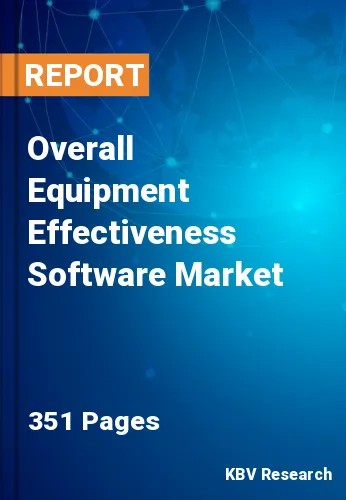
The Global Overall Equipment Effectiveness Software Market size is expected to reach $141.5 billion by 2030, rising at a market growth of 11.2% CAGR during the forecast period.
Companies in the Asia-Pacific region are using cutting-edge technology like the Internet of Things, robotics, and artificial intelligence to expedite their manufacturing processes. Due to the growth of the usage of industrial automation, Asia-Pacific is one of the leading regions in Market and registered a $17,064.5 million revenue in 2022. Moreover, the automotive industry is very promising in APAC region and is expected to acquire approximately 1/5th share of the market by 2030. OEE plays a critical role in the automobile sector by offering a defined metric to evaluate and increase equipment performance, decrease downtime, optimize production procedures, enhance quality, and motivate ongoing improvement initiatives. Using OEE approaches, automobile producers can improve output, cut costs, and boost efficiency.
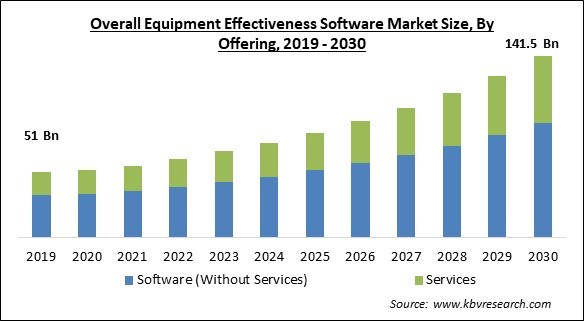
The major strategies followed by the market participants are Partnerships as the key developmental strategy to keep pace with the changing demands of end users. For instance, In December 2021, GE’s Grid Solutions signed an agreement with Fujitsu that brings GE’s OEM expertise in grid asset performance management with Fujitsu's systems management, development, and operations services, to deliver T&D utilities complete support in developing and managing their digitalization projects. Additionally, In June, 2021, Infor came into collaboration with Tresoldi Metalli following which the latter company deployed Infor LN, an ERP solution for manufacturing companies, to assist in enhancing production planning and control, which makes it the most efficient and effective management via the review of business procedures.
Based on the Analysis presented in the KBV Cardinal matrix; Siemens AG, Schneider Electric SE, ABB Group, Emerson Electric Co. and Honeywell International, Inc. are the forerunners in the Market. In April, 2021, Siemens Digital Industries Software collaborated with Fujitsu to improve competitiveness for its customers and empower and boost Digital Transformation in the manufacturing industry. Companies such as General Electric Company and Rockwell Automation, Inc. are some of the key innovators in the Market.
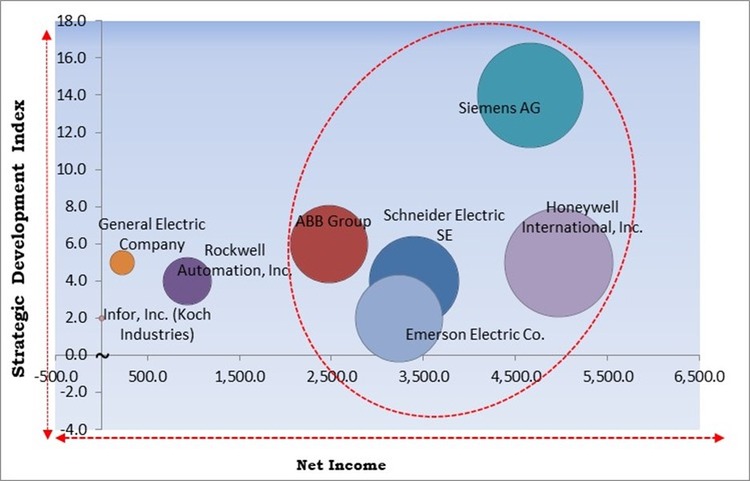
Organizations have chosen cloud ERP models to find the model that best fits their workloads, strategy, and security needs, resulting in the adoption of the finest cloud ERP system. Some advantages of cloud ERP systems for businesses include avoiding the cost of all computer platforms, like hardware and data server platforms, reducing the need for IT services & support because the data center provides IT support, and substituting upfront payment for application software licensing. The market will rise throughout the forecast period due to the growing adoption of ERP software across sectors.
Manufacturing execution systems carry out several tasks, including scheduling & dispatching, examining performance, managing resources & products, gathering data, and auditing data. Manufacturing execution systems are connected with many solutions, including business intelligence, enterprise resource planning (ERP), warehouse management systems (WMS), and e-commerce, to ensure the efficient operation of these processes and the achievement of effective results. These solutions encourage cooperation, data consistency, and effectiveness throughout the product's lifetime. Businesses can use these networked systems to boost OEE, improve equipment use, and optimize their manufacturing processes. The market's demand would thus be driven by integrating various business software during the forecasted period.
The investment cost of OEE software comprises consulting, buying, customizing, implementing, and operating fees, which ultimately raise a company's costs. Prior to adopting factory execution systems, discussions & consultations are included in the consultation cost. Consultation is the greatest method for ensuring this. In contrast, the acquisition cost covers all expenses incurred at the start of a project and is connected to the system's actual purchase. Hardware, application software, system software, and installation charges are included. As a result, these expenditures are substantial, and the companies must also pay for regular maintenance and upgrades. This has the effect of restraining the market.
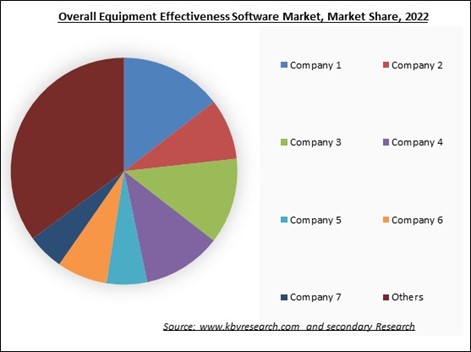
The leading players in the market are competing with diverse innovative offerings to remain competitive in the market. The above illustration shows the percentage of revenue shared by some of the leading companies in the market. The leading players of the market are adopting various strategies in order to cater demand coming from the different industries. The key developmental strategies in the market are Partnerships & Collaborations.
Based on offering, the market is segmented into software (without services) and services. The services segment covered a considerable revenue share in the overall equipment effectiveness market in 2022. Several service options are offered to help organizations enhance the functionality and operational effectiveness of their equipment. Consulting companies, technology suppliers, or specialized OEE suppliers may offer such service offerings.
On the basis of deployment mode, the market is classified into on-premise, and cloud. The cloud segment acquired a substantial revenue share in the market in 2022. Businesses may simply modify their OEE software resources in response to demand due to cloud-based deployment's unmatched scalability and flexibility. This adaptability enables businesses to scale up or down without significant infrastructure investments.
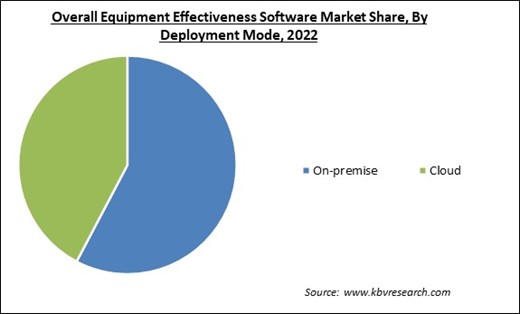
On the basis of industry, the market is classified into aerospace & defense, food & beverages, automotive, chemical, power, metal & mining, oil & gas, electronics & semiconductor, healthcare, and others. In 2022, the aerospace & defense segment generated the highest revenue share in the overall equipment effectiveness market. The aerospace & defense sector uses extremely sophisticated and technologically complicated technology, such as aircraft, satellites, and defensive systems. For the safety & success of the mission, this equipment's effective operation and dependability are essential.
By type, the market is fragmented into predictive maintenance, SCADA, manufacturing execution system, cloud ERP, and data historian. In 2022, the manufacturing execution system segment procured a promising growth rate in the market. OEE extracts data from MES to examine waste, downtime, production count, and other factors. It allows operators to visualize the production line's performance and generate reports according to real-time KPIs. This allows them to spot failing equipment & take the appropriate corrective action.
| Report Attribute | Details |
|---|---|
| Market size value in 2022 | USD 61.2 Billion |
| Market size forecast in 2030 | USD 141.5 Billion |
| Base Year | 2022 |
| Historical Period | 2019 to 2021 |
| Forecast Period | 2023 to 2030 |
| Revenue Growth Rate | CAGR of 11.2% from 2023 to 2030 |
| Number of Pages | 351 |
| Number of Table | 513 |
| Report coverage | Market Trends, Revenue Estimation and Forecast, Segmentation Analysis, Regional and Country Breakdown, Market Share Analysis, Competitive Landscape, Companies Strategic Developments, Company Profiling |
| Segments covered | Offering, Industry, Deployment Mode, Type, Region |
| Country scope | US, Canada, Mexico, Germany, UK, France, Russia, Spain, Italy, China, Japan, India, South Korea, Singapore, Malaysia, Brazil, Argentina, UAE, Saudi Arabia, South Africa, Nigeria |
| Growth Drivers |
|
| Restraints |
|
Region wise, the market is analyzed across North America, Europe, Asia Pacific, and LAMEA. In 2022, the North America region led the market by generating the largest revenue share. In North America, the food & beverage industry has had several decades of steady growth, and this trend is anticipated to continue. To stay competitive and identify the most important areas for development, food and beverage manufacturing companies in the US and Canada are using the advantages of OEE software. These insights into production performance are obtained in real-time.
Free Valuable Insights: Global Overall Equipment Effectiveness Software Market size to reach USD 141.5 Billion by 2030
The market research report covers the analysis of key stakeholders of the market. Key companies profiled in the report include Rockwell Automation, Inc., Siemens AG, Schneider Electric SE, ABB Group, Emerson Electric Co., General Electric Company, Honeywell International, Inc., Infor, Inc. (Koch Industries), Sisense, Inc. and Evocon OÜ
By Offering
By Industry
By Deployment Mode
By Type
By Geography
This Market size is expected to reach $141.5 billion by 2030.
Growing incorporation of MES with ERP and PLM solutions are driving the Market in coming years, however, High cost to be invested initially and rising maintenance & upgrading cost restraints the growth of the Market.
Rockwell Automation, Inc., Siemens AG, Schneider Electric SE, ABB Group, Emerson Electric Co., General Electric Company, Honeywell International, Inc., Infor, Inc. (Koch Industries), Sisense, Inc. and Evocon OÜ
The On-premises segment acquired the maximum revenue in the Market by Deployment Mode in 2022; thereby, achieving a market value of $76.3 billion by 2030.
The Software (Without Services) segment is leading the Market by Offering in 2022; thereby, achieving a market value of $89.1 billion by 2030.
The US market dominated the North America Overall Equipment Effectiveness Software Market by Country in 2022 and would continue to be a dominant market till 2030; thereby, achieving a market value of $36.2 billion by 2030.
Our team of dedicated experts can provide you with attractive expansion opportunities for your business.
